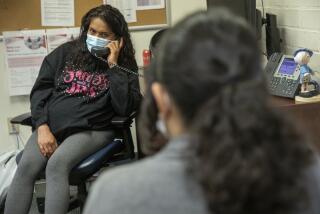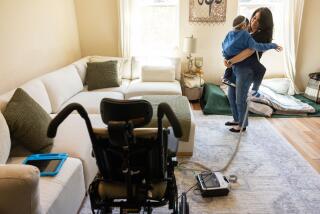Ventilator Patients Assail Medi-Cal : Critics Complain Policies Force Hospitalization
Dozens of Southern California hospital patients, dependent for breathing on mechanical ventilators but nonetheless capable of living at home with proper nursing, are trapped in institutions because of inefficient and unfair state Medi-Cal policies, patient advocates say.
According to an estimate by the Advocacy Group for Ventilator Dependent People, 82 patients--who could be living more happily elsewhere if resources were available--were confined in Los Angeles and Orange county hospitals in 1988.
The problem was highlighted last month when Northridge Hospital Medical Center went to court to evict Shervin Firouzi, a ventilator-dependent patient who had lived at the hospital for nearly two years and had run up hospital expenses exceeding $1 million.
âIn many ways, these people are in prison tighter than Sirhan Sirhan,â said William S. Prentice, a registered nurse who works with ventilator patients at Rancho Los Amigos Medical Center in Downey. âHe gets to face a parole board every now and then.â
Among those trapped is Sarah, a 7-year-old polio victim. She has lived in hospitals since she was 2 months old, breathing with a ventilator.
Abandoned by Parents
Abandoned by her parents soon after she became ill, she could have left Rancho Los Amigos and gone to live with an Antelope Valley foster family six months ago. But the foster family has not been able to find a state-approved home health agency willing to provide her with nursing care at the low rates paid by the state Medi-Cal program.
âShe wants a family,â said Dr. Irene Gilgoff, a pediatrician who heads the advocacy group. Gilgoff said Sarah has been her saddest case.
State Medi-Cal officials argue that, in some cases, the cost of providing the in-home nursing care needed by ventilator-dependent people far exceeds the expense of caring for patients in nursing homes or in so-called subacute hospital nursing units.
They also contend that although most ventilator-dependent patients require around-the-clock nursing care, not all are sick enough to qualify for the more intensive nursing that an acute-care program would provide. In most cases, a patient must be classified as needing acute medical services before the stateâs Medi-Cal program will pay for at-home nursing.
Even if a ventilator-dependent person is deemed eligible for at-home nursing, advocates and attorneys say, the rate the state pays for nurses is inadequate.
The state pays $18.75 an hour for licensed vocational nursing in Southern California. Private insurers pay between $27 and $35 an hour for the same services.
Although the Medi-Cal program has raised its rates several times, partly in response to lawsuits claiming that the low rates were causing patients to be denied services they were otherwise eligible to receive, the rates are still widely considered to be inadequate.
State officials, however, contend that nursing shortages are widespread and would affect patients no matter how high the state sets its rates.
âA lot of patients just stay in the hospital a long time until they can find an agency that will accept them,â said a supervisor at a Santa Ana home nursing agency.
âHorrendous Amounts of Careâ
She said her company, Personal Care Home Health Agency, accepts a limited number of new Medi-Cal patients. But many others do not.
âI think the bottom line is these people require horrendous amounts of care, but they really donât have to be in the hospital, and it could be done much less expensively in outside facilities,â said Dr. Kenneth Cohen, who works with spinal cord-injury patients at Rancho Los Amigos. âIt could save everybody a lot of money.â
Medi-Cal officials dispute that the state could save money by paying for nursing care at home for these patients.
They also deny that large numbers of ventilator patients are stuck in hospitals against their wishes. Darryl Nixon, administrator of Medi-Calâs field office in Los Angeles, said only one person in the county is awaiting a hospital discharge to go home. He said four others are seeking approval to receive nursing care at home.
Nixon said he did not know how many patients had applied for but had been denied eligibility for in-home nursing care paid by Medi-Cal.
That was the situation faced by Firouzi, a 24-year-old quadriplegic whose spine was injured in a 1987 diving accident. Although his brain was not injured, Firouzi depends on a mechanical ventilator to breathe and needs around-the-clock nursing care.
He gets around in a wheelchair controlled by a chin device and has painted canvases that have been displayed in galleries. According to Medi-Cal rules, he is not sick enough to qualify for the intensive nursing care of an acute program.
Firouzi was admitted to Northridge in November, 1987, for what was to be a six-week rehabilitation program. However, he remained at the hospital until earlier this month, when he was transferred to Temple Hospital near downtown Los Angeles.
Northridge had sought to transfer Firouzi earlier, but he and his attorney had resisted the moves because they considered the proposed new programs to be inadequate for handling his medical needs. Finally, the hospital sought to evict Firouzi and filed a lawsuit against him in Los Angeles Superior Court.
Firouzi accepted the transfer to Temple, even though he was placed in a ward where most of the patients are comatose and the nurses require special training to provide for his care.
âHeâs had an enormous amount of problemsâ at Temple, said his attorney, Marilyn Holle of Protection and Advocacy Inc. of Glendale. Protection and Advocacy is a law firm specializing in making sure that the medical needs of disabled people are met.
âThey havenât a clue about the special problems of spinal cord-injured people,â Holle said of Temple Hospital. âThey ask him if something is too tight, or whatever, not figuring out that if you are a spinal cord-injured person, you canât feel.â
Holle has a lawsuit pending against the state Department of Health Services contending that its treatment of Firouzi and other ventilator-dependent patients violates federal laws that require all patients to have equal access to treatment.
She also contends that it would be cheaper for the state to allow Firouzi to live at home with his sister, Doreen, in Canoga Park. Doreen is willing to care for her brother for eight hours a day, meaning that it would cost the state about $300 a day for 16 hours of nursing care. The state is paying about $330 a day for Firouziâs care at Temple Hospital.
John Rodriguez, deputy director of the Department of Health Services, who is in charge of Medi-Cal, said it is impossible to compare the cost of hospital care to the cost of providing 16 hours of nursing.
âOften there are other costs,â Rodriguez said, including the installation of wheelchair ramps, backup generators and other expenses. He urged Holle to contact him directly to determine why Firouzi was not considered eligible for a special waiver program that has allowed patients in similar circumstances to receive in-home nursing care.
But Firouziâs situation is not unique.
Russell Rowland, 39, severed his spine three years ago when he fell while doing sit-ups upside down using gravity boots.
Since the accident, which left him paralyzed from the neck down, he has been at Huntington Memorial Hospital in Pasadena. The hospital, whose cost of treating Rowland has reached nearly $3 million, has been looking for a subacute nursing program where it could transfer Rowland.
Rowland, who is married and has four stepchildren, would prefer to go home, with the state paying for in-home nursing. As a compromise, Rowland would like to go to New Start Homes, a Chatsworth nursing facility that specializes in ventilator-dependent patients. So far, the state has prevented Rowland from pursuing either alternative.
âTheir attitude seems to be letâs warehouse these people somewhere until they die,â Rowland said of Medi-Cal.
Even for those who do qualify for in-home nursing care, there are barriers.
Finding nursing care âis becoming our biggest holdup,â said Pamela DeWitt, a clinical nursing specialist at Childrens Hospital of Los Angeles.
At Childrens, two youngsters--including one who has been waiting 18 months--are ready to go home as soon as nursing services are arranged. Two others are facing a move back to Childrens from their homes because their nursing agencies have decided to stop providing for their care.
Care at Home
One mother whose son was at Childrens for three months finally decided to care for him at home without the assistance of professional nurses. Billy Cothren, who suffers from muscular dystrophy, has required a ventilator to breathe at night since an operation in October.
âWhen we first came home, I didnât know what I was doing,â said his mother, Debbie Cothren, who lives in Claremont. âIt was very scary. Even now itâs bizarre.â
But, she added, âI didnât see any choice in this.â
Rodriguez acknowledged that the complaints of patient advocates and attorneys are sometimes valid.
âTheyâve got a lot of good points,â said Rodriguez, referring to the Advocacy Group for Ventilator Dependent People. âIâm committed to working with them. I will meet with them any time. I donât think they are asking for anything unreasonable.â
More to Read
Sign up for Essential California
The most important California stories and recommendations in your inbox every morning.
You may occasionally receive promotional content from the Los Angeles Times.










